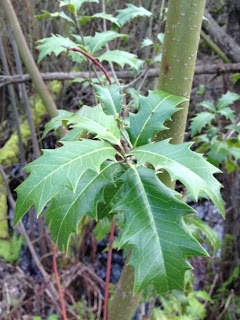Weather: Sunny and warm, strong occassional breeze
Temperature: ~58 F
Time: 5:50 - 7:00 pm
Location: Marsh Island, Washington Park Arboretum
Happy Earth Day! Today was the epitome of a perfect Seattle spring afternoon. The wind began to pick up as I rode my bike to the park, but the sun was still very warm. I walked slowly along the trail, trying not to disturb the peace in hopes of beginning observing birds right away. I veered off to the right to try my luck at the concrete island anchored to the south side of Marsh Island (facing 520). There was a moment of mutual surprise as I startled a Great Blue Heron, and it startled me. It flew off a little further away from the path and settled long enough for me to snap a photo. I have had good luck each week so far in spotting one of these large birds!
Today I focused on observing my surrondings without taking intricate notes-- merely soaking in the sun and the changes in plants since my last visit. I observed a lot more green growth on the shrubs and trees. There were less bird calls, and less birds floating on the water, than the last time I was here. Perhaps it is the time of day? Since it was so late in the evening, the bird activity may have died down. The most notable observation was my own curiosity in identifying plants. I found myself seeing more and more shrubs that had been hidden to my eyes before. I still cannot successfully identify most of them, but my interest in doing so has been piqued.
Below, I have included some photos of the plants I observed most precisely. I tried to take note of their distinctive features and how they may differ from their similar neighbors. Below each photo is a description of the plant and ways to identify it.
Common Horsetail (Equisetum arvense)
Located in moist to wet forests, meadows, swamps; Often weedy
Jointed stems
Scouler's Willow (Salix scouleriana)
Tall shrub or multi-branched small tree with yellowish brown branches
Leaves are broad, alternate, tapered to a narrow base and pointed at top
Young leaves (as shown in photo) are velvety; catkins
Common in wetlands
Yellow Pond-Lily (Nuphar polysepalum)
Aquatic, perennial
Leaves are floating egg or heart-shaped
Flowers are yellow and large
Iris (species unknown)
Leaves are both dark and light green, erect with horizontal dimples/waves near top
About 2-3 feet tall
Lady Fern (Athyrium filix-femina)
Fronds are clustered; Leaves are scaly at base with blades narrow at base and tip
2-3 times pinnate; Located in moist to wet forests and swamps
Pacific Willow (Salix lucida)
Tall and slender shrub/tree
Leaves are alternate and lance-shaped, tapering to a long tip; margins finely toothed
Leaves deep green, not hairy; Catkins
Black Cottonwood (Populus balsamifera trichocarpa)
Large, tall deciduous tree
Bark is dark grey and deeply furrowed
Leaves are alternate, thick, oval, rounded base, sharp-pointed tip
Leaf stalks are round; Margins finely toothed
Sitka Willow (Salix sitchensis)
Tall shrub or tree
Twigs are very velvety
Leaves are alternate, tapering from above the middle to the base
Lower side of leaves satiny
The trail was very muddy (as usual) despite the beautiful weather. |
Unidentified plant! Could not find it in the field guide.... Will continue the hunt next week.
Evidence of a beaver!
Repeat photo of my observation spot (note Black Cottonwood on right).
Repeat photo of my 1 m area.
Invasive species: Blackberry
Invasive species: Holly
Invasive species: Ivy
































